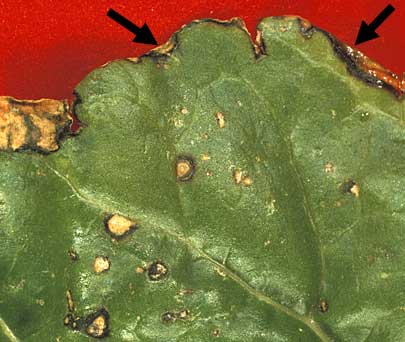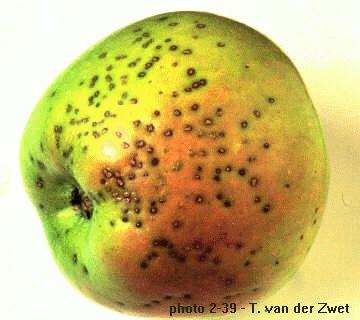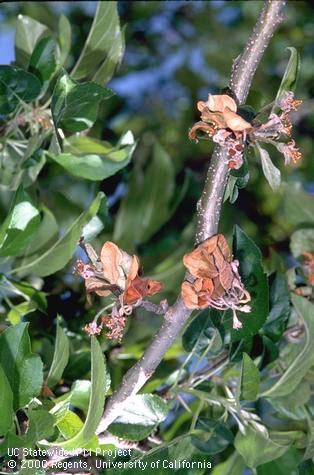|
A continuación se exponen diversos
artículos que esperamos ilustren e instruyan a nuestros lectores.

1. Bacteria Pseudomonas syringae
Bacteria muy polífaga, que ataca a frutales, hortalizas y ornamentales.
El síntoma es manchas y quemaduras sobre todos los órganos de la planta.
La madera enferma adquiere coloración oscura, observándose estrías de
color marrón o anaranjado brillante que se extiende por encima y debajo
de los chancros. En primavera se produce una exudación gomosa y el
chancro se abre, produciéndose, al desarrollarse, el estrangulamiento de
la rama o tronco.
Otras manifestaciones de la bacteria son los ataques a yemas que
aparecen ennegrecidas como si se hubieran quemado. Las infecciones
florales, graves en peral, cerezo y albaricoquero, además de destruir
flores, se producen chancros en los brotes a partir de ese punto.
Tratamiento con kasugamicina al 0,05 %.
www.infojardin.com
2. Blister Spot, Pseudomonas syringae pv. Papulans
I. Introduction: This bacterial disease is of economic importance mainly
on the cultivar Mutsu (Crispin) but can be seen on Golden Delicious when
grown adjacent to Mutsu. Even though fruit grow to maturity and no
detectable yield loss occurs, severe infection results in ugly fruit and
greatly reduces fresh market quality.
II. Symptoms: Infections of blister
spot are first noticeable two to three months after petal fall as small,
green, water-soaked, raised blisters that develop at fruit stomata (photo
2-39). These spots result in purplish black lesions associated with
fruit lenticels. As the fruit increase in size, the lesions expand to
about 3/16 inch (5 mm) and become darkened. A mid-vein necrosis of Mutsu
apple leaves has been observed prior to fruit lesion development (photo
2-40).
 III.
Disease Cycle: The bacterium overwinters in a high percentage of apple
buds, leaf scars, and diseased fruit on the orchard floor. Throughout
the growing season, the bacterium can survive as an epiphyte on foliage
and fruit in the orchard. Even though the highest populations of the
pathogen have been found on Mutsu, the bacterium has also been detected
on foliage and fruit of other apple cultivars. Young Mutsu fruit show an
increased susceptibility to infection for about six weeks, beginning
about two weeks after petal fall. III.
Disease Cycle: The bacterium overwinters in a high percentage of apple
buds, leaf scars, and diseased fruit on the orchard floor. Throughout
the growing season, the bacterium can survive as an epiphyte on foliage
and fruit in the orchard. Even though the highest populations of the
pathogen have been found on Mutsu, the bacterium has also been detected
on foliage and fruit of other apple cultivars. Young Mutsu fruit show an
increased susceptibility to infection for about six weeks, beginning
about two weeks after petal fall.
IV. Monitoring: Earliest spots (photo
2-39) can be detected near the calyx end of the fruit that face the sun
and are on the periphery of the tree, beginning about mid- to late June
in southern fruit-growing areas and mid- to late July in northern areas.
V. Management: The disease is mainly a
problem on the apple cultivar Mutsu. When Mutsu is interplanted with
other (normally) resistant apple cultivars (i.e. Red Delicious, Cortland,
and others), the pathogen may spread into these, also. Prior to the
development of streptomycin-resistant strains of the pathogen, the
disease could be controlled with three well-timed antibiotic sprays, the
first applied no later than 2 weeks after after petal fall, and the
others applied weekly thereafter. This strategy is still employed in
orchards without resistant strains; however, resistant strains may
develop after only a few years of antibiotic use. Once resistance to the
antibiotic develops, further use of antibiotic is ineffective.
Text prepared by T. van der Zwet, K. S. Yoder, and A. R. Biggs
www.caf.wvu.edu
Apple Bacterial Blossom Blast, Pathogen: Pseudomonas syringae
SYMPTOMS
 Fruit
buds infected in early bloom stop growing, turn brown and papery, and
may drop off. Later infections affect flower petals and stems, and fruit
cluster bases turn brown or black. Infection usually does not move
beyond the base of the fruit cluster; sometimes, however, fruit spurs
are killed. Flower symptoms may closely resemble fire blight, but
bacterial ooze is never present with blast as it is with fire blight. Fruit
buds infected in early bloom stop growing, turn brown and papery, and
may drop off. Later infections affect flower petals and stems, and fruit
cluster bases turn brown or black. Infection usually does not move
beyond the base of the fruit cluster; sometimes, however, fruit spurs
are killed. Flower symptoms may closely resemble fire blight, but
bacterial ooze is never present with blast as it is with fire blight.
COMMENTS ON THE DISEASE
Pseudomonas syringae is a widespread bacterium that infects many plant
species and occasionally causes bacterial blossom blast on apples. Frost
or freezing temperatures and free moisture are required for Pseudomonas
infection to occur. Warm, dry weather halts its development.
MANAGEMENT
Bacterial blossom blast is difficult to control. When possible, use
overhead sprinklers to prevent freezing. Monitor temperatures wherever
freezing is most likely to occur in the orchard and turn on sprinklers
when the temperature drops below 34°F (1.1°C). Turning on sprinklers
before the initial drop in temperature helps avoid the damage that
results from evaporative cooling. Uniform coverage of all tree parts to
produce a combination of water and ice is essential. Finally, keep
sprinklers going until temperatures are well above 32°F (0°C) and the
danger of frost is past.
Organically Acceptable Methods
The use of overhead sprinklers to prevent freezing and sprays of copper
or streptomycin sulfate are organically acceptable methods.
Chemical Control
As an alternative to using overhead sprinklers, treat weekly with copper
materials or antibiotics from green tip through bloom if blossom blast
has been a problem and a freeze is likely. Apply chemicals before a
freeze; treatment after symptoms appear is ineffective.
http://axp.ipm.ucdavis.edu
|
![]()
![]()